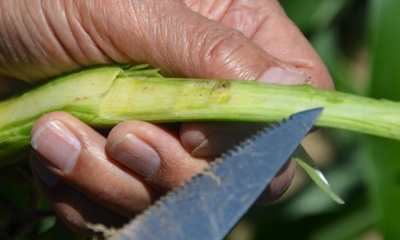
You’ve surely seen TV commercials where someone has an aha moment. If it is not the highlight of their life, it is likely at least the highlight of their day. Suddenly something they didn’t understand becomes crystal clear, or they understand that something they took for granted is really important to them.
Maybe no real whistles blow, bells clang or lights flash, but inside a person’s mind, all that happens and more when they finally understand something or grasp a feeling that has eluded them for a long time.

BELLS GO OFF AND LIGHTS FLASH: Sometimes you have to see something a dozen times before the concept finally clicks! Understanding how leaves push ahead of the growing point in corn can be like that.
I had an aha moment recently while walking with Dave Nanda through the Crop Watch ’16 field before the corn was waist-high. Nanda is a crops consultant for Seed Consultants Inc., sponsor of Crop Watch ’16.
First, here’s the setup: For several years now, I have written stories about how corn grows. A key point in corn development is that the growing point of the plant remains below the soil surface until the fifth or sixth leaf has emerged. This helps explain why corn can regrow if a hailstorm hits or a freak frost occurs relatively early in the growing season. As long as the growing point is belowground, it is still protected from potential threats aboveground.
Even though I’ve written about it dozens of times, for many years I couldn’t wrap my head around how the growing point could stay belowground while corn leaves were growing aboveground. After all, a point is a point, right? It’s typically the leading edge — the tip of a knife, for example. Everything that comes later comes behind the point.
Hard head!
To his credit, Nanda tried to explain the process to me dozens of times over the past few years. Sometimes it was in the cornfield; sometimes it was over the phone or in something he wrote. A year ago he went to great lengths to help me understand that the stalk can elongate while the growing point is still inside, not at the tip. I got it — sort of. I guess "sort of" means I understood it well enough to write about it. Whether I really understood exactly why the growing point remains several inches below the leading edge of the growing plant is likely a stretch.
Recently I accompanied Nanda to the Crop Watch ’16 field, where we try to understand what might be happening in many cornfields based on what’s happening in this field. He immediately started doing what a student of corn does: He dug a plant and began splitting it lengthwise. The plant had at least seven leaves exposed with collars. I had seen him do this many times before.
“There it is, Tom,” he noted. “There is the growing point. It’s above the soil surface already.”
He pointed to a wedge-shaped formation of tissue inside the stalk. The wedge had a point, more or less, headed upward in the plant — hence the term, "growing point."
Aha moment
“The tissue around the point on either side is leaf tissue,” Nanda explained. “It protects the growing point.”
Suddenly the wheels turned and everything clicked into place. I saw the growing point. But I also saw the leaf tissue on either side. The growing point doesn’t extend all the way across to the sides of the stem. There is leaf tissue around it on each side — the tissue that protects it.
“Ah, I get it now,” I said, grinning. “Leaves can be out in front of the growing point because they go around the point. It isn’t a solid wedge across the plant. It’s the center of the plant.”
“You got it, Tom,” Nanda said. “Early leaves go around the growing point as they develop. That is how they can get ahead of the growing point and go aboveground and begin to function while the growing point remains under them. I’ve told you that many times before.”
Maybe he had, but he hadn’t told me and showed me at the same time. This time when I saw the tissue on either side inside the stem, with the growing point in the middle, it all made sense. Leaf tissue could go around the point, grow into leaves, and begin catching sunlight while the growing point was still below the surface.
The lightbulb finally went on! The complicated became simple. So if you struggle with the concept, too, give it time. Split a stalk and study what's inside. Maybe your aha moment is coming soon.
About the Author(s)
You May Also Like




